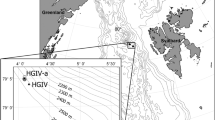Abstract
Sediments and overlying water collected using Multiple Corer (MC) and Box Corer (BC) at three stations in Suruga Bay were compared from the view points of meiobenthic and chemical characteristics. Dissolved oxygen, pH, ammonium and nitrite concentrations of the overlying waters were lower, whereas nitrate and phosphate concentrations were higher constantly in the samples collected by MC than those by BC, suggesting contamination of surface seawater in the BC samples. Sediments were sliced into 0–1, 1–2 and 2–3 cm layers, and water content and Eh, and abundance of meiofauna were analyzed. Water content in MC samples was always higher than BC ones. For the whole meiobenthos, MC collected significantly more individuals than BC at only one out of three stations, whereas for harpacticoid copepods, which aggregated to the surface layer of the sediment, MC constantly collected significantly more individuals than BC. In the vertical profiles of both water content and meiofaunal density, data of 0–1, and 1–2 cm layers in the BC samples were similar to those of 1–2 and 2–3 cm layers in the MC samples, respectively. These results suggested only MC can collect the real sediment surface (so called fluffy layer), which was lost due to bow wave effects in the BC samples.
Similar content being viewed by others
References
Barnett, P. R. O., J. Watson and D. Connelly (1984): A multiple corer for taking virtually undisturbed samples from shelf, bathyal and abyssal sediments.Oceanol. Acta,7, 399–408.
Bett, B. J., A. Vanreusel, M. Vincx, T. Soltwedel, O. Pfannkuche, P. J. D. Lambshead, A. J. Gooday, T. Ferrero and A. Dinet (1994): Sampler bias in the quantitative study of deep-sea meiobenthos.Mar. Ecol. Prog. Ser.,104, 197–203.
Blomqvist, S. (1991): Quantitative sampling of soft-bottom sediments: problems and solutions.Mar. Ecol. Prog. Ser.,72, 295–304.
Gooday, A. and C. M. Turley (1990): Responses by benthic organisms to inputs of organic material to the ocean floor: a review.Phil. Trans. R. Soc. Lond.,A331, 119–138.
Hessler, R. R. and P. A. Jumars (1974): Abyssal community analysis from replicate box cores in the central North Pacific.Deep-Sea Res.,21, 185–209.
Hicks, G. R. F. and B. C. Coull (1983): The ecology of marine meiobenthic copepods.Oceanogr. Mar. Biol. Ann. Rev.,21, 67–175.
Jumars, P. A. (1975a): Methods for measurement of community structure in deep-sea macrobenthos.Mar. Biol.,30, 245–252.
Jumars, P. A. (1975b): Environmental grain and polychaete species' diversity in a bathyal benthic community.Mar. Biol.,30, 253–266.
Libes, S. M. (1992):An Introduction to Marine Geochemistry. Wiley, New York, 734 pp.
Meteorological Agency of Japan (1990):Manual for the Oceanographic Observation. Oceanographical Society of Japan, Tokyo, 428 pp. (in Japanese).
Shirayama, Y. and S. Kojima (1994): Abundance of deep-sea meiobenthos off Sanriku, Northeastern Japan.J. Oceanogr.,50, 109–117.
Thiel, H., K. Lochte, A. J. Gooday, C. Hemleben, R. F. C. Mantoura, J. W. Patching, O. Pfannkuche, R. Riemann, G. Schriever and C. M. Turley (1988): Phytodetritus on the deep-sea floor in a central oceanic region of the northeast Atlantic.Biol. Oceanogr.,6, 203–239.
Thistle, D. (1978): Harpacticoid dispersion patterns: implications for deep-sea diversity maintenance.J. Mar. Res.,36, 377–397.
Thistle, D. (1980): The response of a harpacticoid copepod community to a small-scale natural disturbance.J. Mar. Res.,38, 381–395.
Tietjen, J. (1992): Abundance and biomass of metazoan meiobenthos in the deep sea. p. 45–62. InDeep-Sea Food Chains and the Global Carbon Cycle, ed. by G. T. Rowe and V. Pariente, Kluwer Academic Publishers, Netherlands.
Author information
Authors and Affiliations
Rights and permissions
About this article
Cite this article
Shirayama, Y., Fukushima, T. Comparisons of deep-sea sediments and overlying water collected using Multiple Corer and Box Corer. J Oceanogr 51, 75–82 (1995). https://doi.org/10.1007/BF02235937
Received:
Revised:
Accepted:
Issue Date:
DOI: https://doi.org/10.1007/BF02235937




